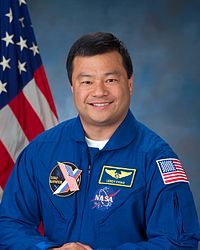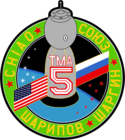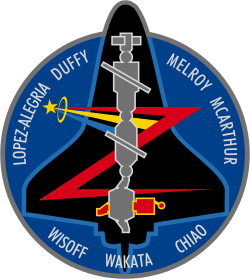Leroy Chiao
| Leroy Chiao | |
 Leroy Chiao. | |
| NASA-astronaut | |
|---|---|
| Tillstånd | Ej aktiv |
| Född | 28 augusti 1960 |
| Urvalsgrupp | Astronautgrupp 13 den 17 januari 1990 |
| Uppdrag | STS-65, STS-72, STS-92, Sojuz TMA-5, Expedition 10 |
| Uppdragsemblem | |
Leroy Chiao, född 28 augusti 1960 i Milwaukee, är en amerikansk astronaut uttagen i astronautgrupp 13 den 17 januari 1990.
Rymdfärder
- STS-65
- STS-72
- STS-92
- Sojuz TMA-5
- ISS Expedition 10
Källor
”Biographical Data” (på engelska) (PDF). NASA. december 2005. https://www.nasa.gov/wp-content/uploads/2016/05/chiao_leroy.pdf?emrc=004973. Läst 10 maj 2024.
|
Media som används på denna webbplats
STS-65 Mission Insignia
This Soyuz TMA-5 patch was designed by Alex Panchenko:
"I've started design works of patches for Soyuz TMA-5 (ISS-10 flight) back in July 2004, when first sketches - drawings made in Starbucks coffee and later presented them for approval to Soyuz commander S. Sharipov. It was still not clear who is going to be third crew member of Soyuz and in this case I was preparing for Soyuz TMA-5 flight design in two variants (with name of Polonsky and with name of Shargin - both candidates on third seat in Soyuz).
During design work with Soyuz TMA-5 patch my idea was to present Soyuz panels as symbolic flags of Russia and United States, and base of design is a window view outside. Crew names are in the same order as their actual seats inside Soyuz. Commander S. Sharipov in center, L. Chiao on the left from commander and Y. Shargin on the right side."
Designed by the crew members, the STS-92 patch symbolizes the second mission to carry U.S.-built elements to the International Space Station (ISS) for assembly. The black silhouette of the Space Shuttle Discovery stands out against the deep blue background of space in low Earth orbit. In the foreground in gray is a profile view of the ISS as it appears when the shuttle and crew arrive, with the station consisting of the Unity node, its two pressurized mating adapters (PMA), the Zarya functional cargo block, the Zvezda service module, and the Progress cargo vehicle.
Following the shuttle's rendezvous and docking, the ISS configuration will be augmented by the two elements delivered by Discovery–the Z1 truss and PMA-3. These two elements, depicted in red, will be installed using the shuttle's robot arm and be connected to ISS during four spacewalks. The multi-national nature of both the STS-92 crew and the ISS are reflected in the multi-colored Astronaut Office symbol.
The Expedition 10 patch uses simple symbolism to describe the mission. The large Roman numeral "X," formed by the American and Russian flags, symbolizes the joint nature of this mission, as well as the fact that this flight is the 10th mission to stay on the International Space Station (ISS). The current configuration of the ISS is next to the name of the ISS Commander, while the Soyuz vehicle is placed next to the name of the Soyuz Commander. The single star and the black background signify this is a space mission.
STS-72 Mission Insignia





